#Ulster Unionist Party
Explore tagged Tumblr posts
Text
#OTD in 1969 – Bernadette Devlin was elected MP for Mid Ulster, standing as the Independent Unity candidate; at 21 years old, she was Britain’s youngest ever female MP and the third youngest MP ever.
Devlin was born in Cookstown, Co Tyrone to a Roman Catholic family. She attended St Patrick’s Girls Academy in Dungannon. She was studying Psychology at Queen’s University Belfast in 1968 when she took a prominent role in a student-led civil rights organisation, People’s Democracy. Devlin was subsequently excluded from the university. She stood unsuccessfully against James Chichester-Clark in the…

View On WordPress
#Belfast#Bernadette Devlin#Bernadette Devlin McAliskey#George Forrest#Irish Republican Socialist Party#Mid-Ulster constituency#Northern Ireland general election#Queen&039;s University#Seamus Costello#Ulster Unionist Party Member of Parliament for Mid Ulster#Unity ticket
8 notes
·
View notes
Text
Reflections of a Statesman: The Writings and Speeches of Enoch Powell :: Enoch Powell

View On WordPress
#0-9477-9288-0#bob vickers#books by enoch powell#british#british government#british history#british politicians#british politics#conservative party#first edition books#government 20th century#political history#political speeches#politics b#rex collings#ulster unionist
0 notes
Text
"The probable Liberal candidate for Mid-Devon at the next election"
I thought it might be worth discussing this line in more depth, with some further points about elections in late Victorian Britain, with some reference to the recent one.
Funnily, you can actually got through this largely word by word.
The
While many of them had been abolished, there were still a number of seats that elected two MPs, such as Bath and Devonport.
You still had some "university constituences" where Masters and Doctorate level graduates could vote for two MPs. These would persist until the 1950 General Election.
The UK has pretty much always used the plurality system for General Elections aka "first past the post". Highest number of votes wins. This can result in someone getting in with 34% of the vote, which happened at the 2024 election.
In the case of a two-member seat, the top two candidates got elected. This multi-member practice is still standard for local council elections.
Probable
The UK election period is pretty short. The last election had Rishi Sunak ask the King for a dissolution on 22 May, Parliament dissolved on the 30th and the deadline for nominations on 4 June, a month before the actual election on 4 July.
The Victorians had the actual voting spread over 24 days in the 1892 election; it was possible for a candidate to lose one election, quickly get nominated in another seat and win that one.
Candidates would not therefore be fully confirmed under the formal nomination by their local party, although today the national party has a good deal of control over the process:
However, it is today common place to have "prospective parliamentary candidates" in place before an election is called. This allows them to campaign without becoming formal candidates and being subject to our strict electoral spending rules.
The UK also has its own equivalent of "carpetbaggers", known as "parachute candidates". Party HQ will "parachute" someone they want into a safe or winnable seat, frequently to the at least mild displeasure of the local party. Notable parachutists include George Galloway, Boris Johnson, Margaret Thatcher and Roy Jenkins.
Liberal
The UK had three major parties in 1889:
The Conservative and Unionist Party, generally shortened to the Conservatives or the Tories. Led by the Marquess of Salisbury, the incumbent PM since the election of 1886 gave him an overall majority. The latter is an insulting term derived from an Irish word for "outlaw", but today can be used in a neutral way - the BBC's Style Guide allows it to be used for later references. The Conservatives do not use it themselves formally. The Unionist part referred to their support for the union between Great Britain and Ireland; they had significant support in the (more Protestant) Ulster province of the latter, six of the nine counties of which would become Northern Ireland. As such they opposed "Home Rule" i.e. Irish self-determination in domestic affairs with their own parliament, although Salisbury's government did implement various reforms in Ireland seeking to "kill Home Rule by kindness". They generally favoured protectionism and a policy of keeping Britain out of foreign alliances.
The Liberals: Led by William Gladstone, considered one of our greatest Prime Ministers. Known as the G.O.M. (Grand Old Man or God's Only Mistake, depending on your POV), he had been Prime Minister for the third time during a short-lived 1886 ministry started and ended over Home Rule - he'd forced out Salisbury by a defeat over the matter with Irish support, then had his legislation defeated in the Commons, forcing an election. The Liberals had split over Home Rule, a Liberal Unionist wing aligning with the Conservatives and eventually merging with them. The Liberals favoured increased worker rights and expanding the franchise.
Irish Parliamentary Party: Made up of Irish nationalists (commonly, but not always Catholic) who wanted autonomy and land reform, they were led by Charles Stewart Parnell. Opposed to militancy in the name of Home Rule or even full independence, which was getting quite common at this time. Parnell would foil an attempt to smear him as pro-violence by forged letters claiming he was complicit in a double assassination in Phoenix Park in 1882; he requested an official enquiry and the journalist, Richard Piggott, broke down under cross-examination. Piggott was then sued for libel by Parnell, lost, then fled to Madrid where he shot himself. However, the following year, Parnell was revealed via a divorce trial to have had a long affair with a married woman called Katharine ("Katie" to her friends, "Kitty" to her enemies, the latter being a slang term for prostitute) O'Shea, fathering three of her children and "living in sin" with her. The scandal was huge, with the Catholic Church coming out against him. Refusing to resign, the party split, with the majority becoming the anti-Parnell Irish National League. Parnell married Katherine in 1891, but his health was failing due to stomach cancer and heart disease - he would die in her arms four months later. His minority faction collapsed shortly after.
While trade unions were a growing political force, the Labour Party had yet to really come into being.
Candidate
In 1892, there were 6.16 million registered voters, therefore eligible to run for the House of Common. As is obvious, universal suffrage was not a thing at this point.
This page covers the qualifications to vote and ergo, I believe, run in 1900:
For further explanation:
Of full age means over 21. The UK lowered the age to 18 in 1969, two years before the US did.
Receipt of what we would today call benefits, bar medical ones, meant no vote. Insert your own joke here.
Conviction for corrupt electoral practices also cost you your right to vote. Being incarcerated after a conviction (but not if you are on remand) today also bars you from voting, but this does not carry over after your release.
Alienage means being a foreigner, not being an extraterrestrial.
Looking at this, I believe that both Watson and Holmes would have been eligible voters. Certainly later in their careers.
Peers were and still aren't eligible to vote or run for the House of Commons. Baronets are hereditary knights and therefore not peers.
You could run as an independent candidate, but these winning were pretty rare. Having just two candidates on the ballot paper was not uncommon either.
The secret ballot having been introduced in 1872, voters would now going into a booth or partitioned area and mark their choice with a 'X', the traditional signature of the illiterate. We have never used voting machines here. It would then be dropped into a padlocked metal box.
The ballots would contain the name of the candidate and their residence. It would not have their party affiliation on it. Candidates would have to explain via posters and leaflets who supporters should vote for:
A candidate could not pull out after nominations closed - if they died and weren't an independent, the election would have to be re-run. In 2024, a number of candidates lost their party endorsement due to various controversies at the point it was too late to take them off the papers.
Mid-Devon
Our parliamentary consituencies have names, unlike the numerical districts used for the US House of Representatives.
Redistricting or boundary changes were and are done by independent boundary commissions. The Redistribution of Seats Act 1885 created three commissions (England & Wales, Scotland and Ireland) with the new requirement to keep elector populations broadly equal in each seat. Seats were expected to be compact and follow local boundaries where reasonably practical; none of those silly American district shapes here, thank you.
No further boundary changes would be done until 1918.
Mid-Devon is fictituous - I have not been able to find the name of the relevant RL consituency for the area.
Next Election
Barring the period between 2011 and 2022 where elections were fixed or required the Commons to authorise them by a 2/3 vote, the date of the next election is in the gift of the Prime Minister, who must call it within five years of the last election. In 1889, it was seven years.
The PM can ask for a dissolution and new election from the monarch at any time in that period, which is nearly always granted unless there is a viable alternative government available.
PMs generally try to call an election at the best time for them politically; sometimes it's expected, other times it will wrong foot people. The 2024 election being held in 4 July surprised nearly everyone, including many in Sunak's own party.
Salisbury called the election for 4 to 26 July 1892. The results saw the Conservative/Liberal Unionist alliance lose its overall majority, but Salisbury hung on until 12 August when the Liberals and INL collectively defeated the government in a vote of no confidence. Salisbury resigned and advised Queen Victoria to send for Gladstone. The latter, now 82, formed a minority government reliant on Irish Nationalist votes and made another attempt at Home Rule in 1893, blocked by the Lords.
Gladstone would resign the following year on health grounds and Victoria then selected Lord Rosebery to succeed him, basically as he was the only Liberal she liked.
Further notes
The House of Lords and the House of Commons were equal in power at this point; the former could therefore veto bills and block the budget.
Results were and still are announced in public declarations, these days televised. The candidates going up on the stage are privately told by the Returning Officer the results, then told not to show any sign of what has happened as they go up. It's very much poker face time.
Postal ballots are a thing, but they must be returned by close of poll on election day.
The former practice of "chairing", basically a victory parade involving the new elected member sitting on a chair and being carried around the town, had stopped in 1880.
The Oaths Act of 1888 eliminated the requirement of members to swear an oath of allegiance to the monarch, allowing them to affirm instead. This allowed non-Christians to take their seats, as well as those Christians who do not agree with swearing oaths. It is now possible to use any religious text you like when doing the oath or affirmation. However, the allegiance to the monarch bit remains to this day - Sinn Fein, who wish to see Northern Ireland become part of Ireland, refuse to take their seats because of this, while a number of MPs did this bit under protest because of their opposition to the monarchy.
12 notes
·
View notes
Text
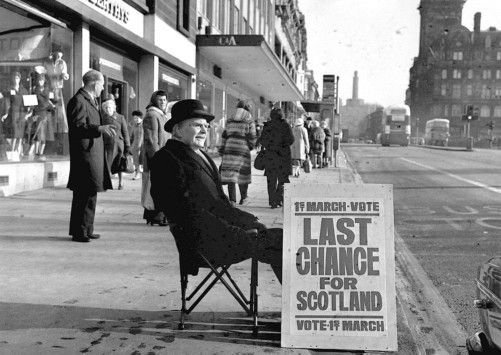
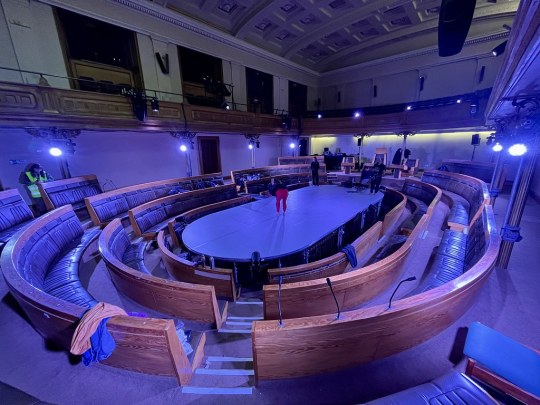
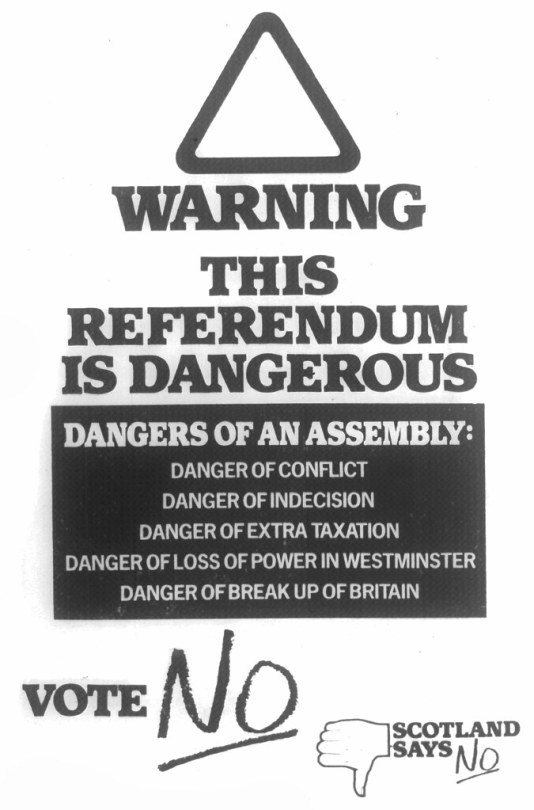
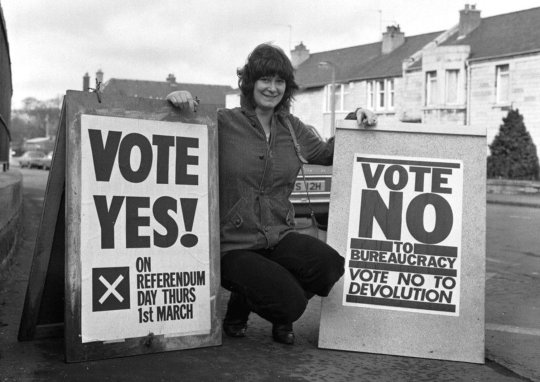
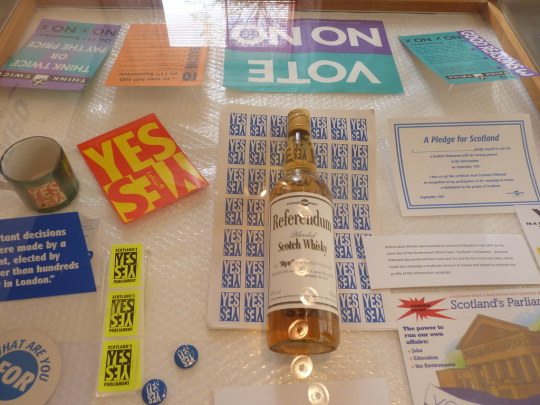
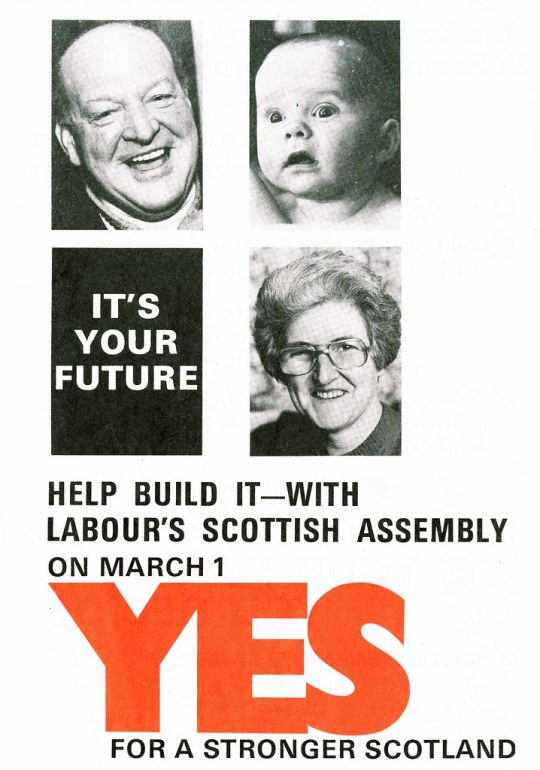
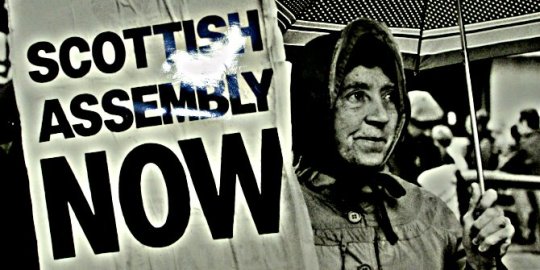
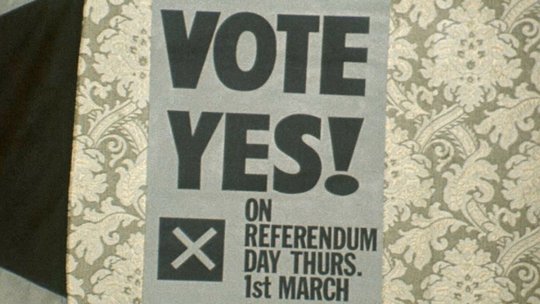
On March 1st 1979 Scots voted in favour of Devolution, but failed to reach the required 40% of the population in favour of implementing it - due to 36% of the electorate not voting.
THE PLOT.
The introduction of devolution legislation in 1976 was largely the product of nationalist pressures on the Government. James Callaghan's Labour government had a majority of only three after the 1974 (October) election and by 1977 had no majority at all after a series of by-election defeats. The government was therefore vulnerable to pressures from the Scottish National Party and Plaid Cymru, who between them won 14 seats at the election (SNP 11, Plaid Cymru 3). The Kilbrandon commission had reported in 1974, recommending the establishment of a Scottish parliament and endorsing the principle of devolution.
A combined Scotland and Wales Bill was introduced in November 1976. It gained a second reading only after referendums in both Scotland and Wales had been conceded. The Shadow Secretary of State for Scotland, Alick Buchanan-Smith, and one of his front benchers, Malcolm Rifkind, resigned their posts when the Shadow Cabinet decided to oppose its second reading. On the first day of committee 350 amendments were put down. Michael Foot, (then Lord President and Cabinet Minister responsible for the devolution bill) was reluctant to impose a guillotine. After nearly 100 hours of debate only three and a half clauses of the bill had been considered. A guillotine motion was tabled but defeated in February 1977. The Bill was withdrawn.
In November 1977 separate Bills for Scotland and Wales were introduced, with support from the Liberals. This reduced opposition from those who had previously opposed the combined Bill on the grounds that the Welsh did not really want devolution. This time the guillotine motion was won.
As the committee stage was nearing its end, it scrutinised an amendment from Labour backbencher George Cunningham. It required the Secretary of State to lay before Parliament an order repealing the Act unless at least 40% of the eligible electorate voted "yes". The amendment was strongly opposed by the Government, but they lost the vote by 166 votes to 151.
In the referendum, on 1st March 1979, Scotland voted in favour of devolution by 52% to 48% - but only 32.9% of the electorate had joined the majority. In Wales the vote was against devolution, by 80% to 20%. The Acts were repealed the next month.
The Government was not helped by the extent of internal dissent within the Labour party. There was an active Labour 'Vote No' campaign in Scotland, of which Brian Wilson was Chairman, and Robin Cook a Vice-Chairman together with Tam Dalyell.
In Wales, Neil Kinnock was among those who campaigned for a "no" vote. During the last few days of the campaign in Wales, the pro-devolution Labour party -TUC group argued that a "No" vote would be a vote for the Tories, and a vote against the Government. This was a gamble that did not pay off; the scale of the "No" victory meant that those who had campaigned against the government could feel vindicated.
A motion of no confidence in the government was tabled by the Conservatives and supported by the SNP, the Liberals and eight Ulster Unionists. This motion was carried by one vote on 28th March 1979. The next day Callaghan announced that Parliament would be dissolved.
The 1979 Results:
Scotland: Question: Do you want the provisions of the Scotland Act 1978 to be put into effect ?
Yes 1,230,937 (51.6%)
No 1,153, 502 (48.4%)
Rejected ballot papers 3,133
Electorate 3, 747,112
Turnout 63.6%
But, we Scots are known the world over for this saying. Try, try and try again we did and won our parliament. We did and we put the party in powder who would take us to freedom. We will never give up our fight to be an Independent country once more.
22 notes
·
View notes
Text
Ireland’s relationship with Israel is simply incomprehensible.
While both Dublin and Jerusalem are democracies and share common historical experiences with British colonialism—the British Mandate in Palestine and the Irish struggle for independence—Ireland today is the most viciously anti-Israel and pro-Palestinian member of the European Union. Ireland leads the European nations in anti-Israel, pro-BDS campaigns.
Sinn Féin, the political arm of the former terrorist Provisional Irish Republican Army (IRA), is now Dublin’s leading political party. The IRA received training supported by the Soviet Union in Lebanon’s Bekaa Valley together with the Palestinian terrorists in the 1960s and 1970s. There exists a counterbalance to Dublin’s intensely pro-Palestinian sympathies; the Ulster Protestants in Northern Ireland, who are the most pro-Israel members of the British Parliament. Brian Kingston, a member of the Legislative Assembly of Northern Ireland and a Democratic Unionist Party (DUP) politician, remarked in a recent interview: “The unionist community in Northern Ireland has a long-standing affinity and affiliation to the cause of Israel.”
The IRA played a role during World War II in supporting German Nazis. Although the government of Ireland was officially neutral, the IRA collaborated with the Nazi military intelligence. Adolf Hitler sent money, transmitters and spies to Ireland. Moreover, the IRA provided the Nazis with targeting information on British installations in Belfast. After Hitler committed suicide in April 1945, Ireland’s wartime leaders—President Douglas Hyde and Prime Minister Éamon de Valera—offered official condolences to the Nazi envoy in Dublin.
More recently, the Hezbollah terror group’s unprovoked attacks on Israeli communities in northern Israel, which began on Oct. 8, 2023—one day after the Hamas terrorist attacks in southern Israel—did not stir Ireland’s peacekeepers in the U.N. Interim Force in Lebanon (UNIFIL) to try and stop the shelling attacks nor did they call to impose the U.N. Security Council Resolution 1701. Passage of that resolution came in the wake of the summer 2006 war between Hezbollah and Israel, and called for the disarmament of all armed groups in Lebanon—in particular, Hezbollah’s disarmament. Resolution 1701 established that no armed forces, other than UNIFIL and the Lebanese Armed Forces, could be south of the Litani River in Lebanon. Yet Hezbollah remained.
The Israel Defense Forces, in response to Hezbollah’s attacks during the last year, have moved from an aerial campaign to ground operations in Southern Lebanon to clear out Hezbollah forces. Israel has requested that the Irish contingent and all of UNIFIL move out of harm’s way. Ireland’s deputy premier and minister for defense and foreign affairs, Micheál Martin, responded by saying that he “strongly condemns” the IDF targeting and firing on the UNIFIL positions. Israel has repeatedly stated that it has no quarrel with the Lebanese people and certainly not with any of the UNIFIL peacekeepers.
This new dispute regarding the Irish peacekeepers comes after Ireland, Norway and Spain unilaterally recognized Palestinian statehood in May, essentially rewarding the Palestinians for the massacre of 1,200 Israelis by Hamas and the kidnapping of 250 others as hostages on Oct. 7, 2023.
The tensions aren’t just in the political arena. Members of an Irish women’s basketball team refused to shake hands with their Israeli counterparts during a pregame meeting in February’s FIBA EuroLeague Women’s tournament. The Israeli team ended up defeating the Irish team, 87-57. The behavior of the Irish national team was the same as the Islamic Republic of Iran’s team and teams from Israel’s Arab enemies in other tournaments.
Ireland was the first member of the European Economic Community (EEC)—the precursor of the European Union—to declare in 1980 their support for Palestinian statehood. Additionally, Ireland didn’t establish diplomatic relations with Israel until 1975 and first opened its embassy in Tel Aviv in 1996, long after other Western European nations.
When Israel retaliated against missile attacks launched from Gaza by Hamas and Palestinian Islamic Jihad in May 2021 during an 11-day conflict, the Irish government was the first E.U. state to condemn Israel, alleging the de facto “annexation of Palestinian land.” The issue propelling this condemnation was the decision by the Israeli Supreme Court affirming Jewish ownership of homes in the eastern Jerusalem neighborhood of Sheikh Jarrah. It was an example of brazen Irish interference in an Israeli legal matter that had nothing to do with annexation.
Ireland has transformed from being an intensely Catholic state to an equally intense secular one. While the young Irish have moved away from their church, they are eagerly accommodating Islamists who seek to undermine and destroy the Judeo-Christian way of life. Ultimately, they will learn that Islamists seek to destroy their Irish culture as well.
The Catholic Church in Ireland had an antisemitic past but with Ireland becoming increasingly secular, the antisemitism of today is no longer of the religious variety. It has the marking of a leftist, ideologically driven hatred dressed as anti-colonialism. Dublin has adopted the Palestinian narrative without questioning or searching for the truth. Arab-Islamic colonialism is rarely if ever discussed, and Palestinian terrorism is largely excused. The fact that the Palestinians have rejected every opportunity for self-determination and statehood does not bother the Irish government. What the Palestinians want is the disappearance of Israel and the Jews. It seems that Dublin is OK with that.
Relations between Ireland and Israel have been strained for years and with Sinn Féin growing power in Dublin, the relationship isn’t likely to improve and may only get worse.
3 notes
·
View notes
Text
"New analysis out today from the Fawcett Society and Democracy Club shows just how far we have to go to achieve truly equal gender representation. Currently, fewer than 5% (18 or 382) of local councils have achieved at least parity in gender representation. That means, based on the current rate of change, we won't see 50:50 representation until 2051. Fawcett regularly conducts analysis of women's representation in local authorities in lieu of any official government or political party monitoring. Our analysis shows:
In August 2022, just 36% of the 19,212 elected councillors across the UK were women. This is similar to representation of women in the House of Commons (35%)
At a regional level, no council has gender parity, with London the highest at 45% women and Northern Ireland the lowest at 26%.
The proportion of women in councils in 2022 is only 2 percentage points higher than in a snapshot taken in 2018
No party has gender parity, though there is significant variation. The highest proportion of women is found in the Labour (47%), Green (43%) and Scottish National Parties (41%), whilst the lowest proportion is found in the Conservative Party (29%), the SDLP (29%), DUP (21%) and Ulster Unionist Parties (20%)."
Read the full piece here: https://www.fawcettsociety.org.uk/new-data-from-fawcett-shows-95-of-local-councils-are-male-dominated
43 notes
·
View notes
Text
Ok stuff's been happening in the world of UK politics and I need to share it with you before I scream.
So first, some important context. Way back in the 1920s when Ireland left the UK, the province of Ulster, by this point predominantly Protestant, remained, splitting from the rest of the nation. However, as is always the case with partition, it wasn't a clean break: people got stuck on sides of the border they weren't necessarily happy with, and over time, historical political and cultural divides were exacerbated by a new concrete separation that culminated in the Troubles, a period of violence in NI between the 1970s and the 1990s as radical nationalists (the IRA) clashed with the UK military over control of the region. This was largely ended in 1998 by the Good Friday Agreement, tearing down the hard border across Ireland and facilitating free movement of goods and people. In order to preserve the peace, a power sharing mechanism was implemented in Stormont (NI's assembly) whereby the government had to consist of two equal and codependent parties. The first minister was from the party who won the elections, the deputy minister was from the opposition, etc. This system worked well enough at suppressing Unionist/Nationalist tensions for about 20 years and was considered one of the greatest diplomatic achievements of British and Irish history.
Flash forward to 2016, and the UK votes to leave the EU. Overall. Within the nations, it's a different story, and while Scotland's desire to remain gets most of the press, Northern Ireland also voted disproportionately to remain. And as the Conservatives would discover, they kind of had to.
Because you see, a big part of the reason why the Good Friday Agreement worked is because both parties were EU members, so they were already part of the Single Market, meaning free movement of goods and services wasn't an issue since it was already European policy. Now Britain wants to leave the Single Market, we have an issue.
If you were looking at memes around 2017, you'll be familiar with the term 'Hard Brexit'. What that means is the UK is fully cut out of all the various levels of EU membership: the free trade, the external tariffs and, most importantly, the regulatory framework of the Single Market that allows goods to be easily traded across borders. As you may also know, the EU takes regulation very seriously, so ensuring imports are up to code is a lengthy and time-intensive process. If Britain wants a Hard Brexit, and they're cut out of the Single Market, there has to be a point where goods being traded in and out of countries still in the framework are checked. Say, for instance, in Ireland.
One problem: this entails a hard border. Not for people, perhaps, but for products, and people need products to make a living. On top of that as well, Northern Ireland would be cut out of the free trade area and potentially face massive import duties, massively increasing costs and threatening demand. Even on a symbolic level, its a firm dividing line across Ireland. And the Good Friday Agreement is very clear about the No Borders thing because Look What Happened The Last Time There Was A Border. If the Conservatives try and surround the UK with a hard customs border, Northern Ireland will fall.
But the alternative is either not having a Hard Brexit, the entire point of their manifesto, which would be political suicide, or leaving Northern Ireland behind basically in the EU, creating a border not across Ireland but across the UK. And if that happens, Northern Ireland will fall because of the radical unionists.
(Alternatively the solution was 'No Brexit in the first place' but too late for that now ig.)
David Cameron resigns before having to sort this out. Theresa May spends her entire premiership trying to sort this out while part of a coalition with the DUP (the leading Unionist party, at this point the largest party in Stormont and basically NI's Tories) and she can't, forcing her resignation. Then Boris Johnson comes along and finds a 'temporary' solution to get the paperwork signed: put the border between Great Britain and Norther Ireland, keeping Good Friday intact, until they can find a better way. Until then, Northern Ireland abides by EU trade regulation and future amendments: the Northern Ireland Protocol. And they wait. And they wait. And they don't.
As this shitshow is going down, Northern Ireland is getting increasingly tired of Westminster's routine (and the DUP's dumpster fire coalition attempt) and pivots towards new kid on the block, the party of compromise, Alliance. The Nationalists, led by Sinn Fein, lose votes through this too, but to a far lesser degree. DUP loses 10% of the vote share in the 2017 election, putting them and Sinn Fein neck and neck.
And in 2022, for the first time, Sinn Fein wins Stormont. The nationalists are in power in Northern Ireland. Or rather, they're half in power.
Because as we established, Northern Ireland has a power sharing system. And the DUP have boycotted Stormont. They aren't happy with the potential of being pulled away from the UK, so they decide if they can't have NI, no-one can. By refusing to participate in the coalition government, the Sinn Fein half is prohibited from governing alone, forcing the government into shutdown.
That shutdown has lasted for a year.
This happened around the time Boris Johnson started sinking over Partygate, followed by whatever the fuck happened with Truss, so NI got overshadowed in the news cycle but over the course of 2022, order has been breaking down in Northern Ireland as radical unionists begin to stir trouble. Indeed, it looks like Northern Ireland is heading straight back to the Troubles, and no-one seems to want to do anything to fix it. In fact, the Conservatives seem to want to declare war with the EU through a proposed override of the Protocol, dismantling decades of diplomatic hard work and plunging the continent into anarchy.
In October, Rishi Sunak is 'elected' Prime Minister, and he sets out to solve the Northern Irish issue. For all her many faults, Truss was pretty cordial with Europe, and Sunak continued that trend well into his premiership. Combined with the looming threat of Russia over European stability, the EU is in a compromising mood, and agrees to help work out a new system that tears down the border between the UK and Ireland. The plan is: separate goods going to Northern Ireland and goods going to the EU. Why it took them 7 years to sort that out I don't know but huzzah, a solution. But on top of this, they also implement the Stormont Brake: whereas before, EU law applies automatically in Northern Ireland, Stormont can veto proposed amendments from applying in Northern Ireland if they're too radical. This is a hugely generous concession by the EU since this is a major compromise on a lot of their core principles, since Northern Ireland is now part of the Single Market but theoretically exempt from following it, and by extension a huge win for Rishi Sunak. While the DUP have lost all credibility, this will hopefully be enough to get them back into Stormont. This new arrangement is called the Windsor Framework, and buries the final major hatchet in the Brexit divorce proceedings.
OK, LENGTHY context complete, lets discuss what's happened. Because turns out, there's opposition to this new framework.
Who from?
WHY ITS BORIS JOHNSON AND THE CHUCKLEFUCKS.
Basically, leading members of the Johnsonian and Trussian governments (including both PMs) explicitly said they wouldn't support the deal. They don't have an alternative. A plan. Anything. They just won't support it.
Joining them is, you guessed it, THE FUCKING DUP. No matter what happens, they're refusing to go back to Stormont. Just to spite their rivals.
Some more important context, the Conservatives are on the verge of self destructing since vast swathes of the party believe Johnson is a martyr and Sunak is not the True King, so getting the Conservatives to vote together is a massive challenge. If this vote passes, it'll give the Tories a lifeline to the next election, possibly their one positive achievement since 2016 outside of 'not actively backing Putin'. If it fails, the Conservatives are history. Making matters worse in the best way, Keir Starmer pledges Labour's plurality in support of Windsor, saying, to paraphrase, 'if you fucks can't get it together we'll do it for you.' Iconic. By doing so, Labour guarantee the vote passes unless the entire Conservative party rips itself in twain, but potentially force the PM to rely on the OPPOSITION over his OWN PARTY to pass groundbreaking legislation, which is almost worse for Sunak than the bill failing.
The vote took place today and the Conservatives, despite a massive rebellion, barely managed to vote in favour on their own majority alone. Barely. We're talking single digits. Two dozen Tory MPs rebelled, and 3 dozen more abstained. With no alternative. They would rather have chaos in Northern Ireland than be forced to work with the EU when the EU is bending over backwards to make this happen.
Today is a positive for the UK's future, but it reaffirms that the Conservatives need to go now more than ever.
#uk politics#northern ireland#windsor framework#long post#stormont#sorry for the long post i just needed to vent#i hope its accurate if its not ill make edits
34 notes
·
View notes
Text
It's been a few days since my last post, and I've been mostly at work or busy with work-related things, especially since the recent elections have stirred up quite a bit of tension.
Labour won the general election, yes, that's true, I know that. That's all great for England where they actually do stuff. It's brilliant for them. Up here though, it doesn't really matter if it's Labour or Tories, so those election results aren't the insanity-fuel I've been dealing with at work. No, that's in the Democratic Unionist Party (DUP)'s loss. They lost 3 seats in Westminster, which isn't a lot until you realise they only had 8 to begin with. Sinn Féin had 7. They remain at 7, but the DUP's loss means that now, Sinn Féin are the largest Northern Irish party in the UK Parliament. On the other hand, the Traditional Unionist Voice (TUV) gained a seat, which is less than encouraging news for many and sparked a row here at work the day the news came out. Lots of angry people. Lots of... slightly depressing comments about Protestants in general, which is a little disappointing, but I do get where they're coming from... if you thought dealing with the DUP was tough, brace yourself - the TUV is even more hardline. It makes sense they got a seat, though. The DUP have been alienating voters for a while now and the TUV, alongside the Ulster Unionist Party (UUP) and an independent unionist, are there for those voters to flee to.Still not exactly great.
But yeah, now that's all starting to calm down again.
My (and it still feels weird to not say our) birthday is coming up which is slightly painful for obvious reasons but also quite exciting because I'll be turning 19 and that sounds so ridiculously old to me. It's a strange age imo. Not quite an adult, but definitely not a kid anymore. It's an in-between age where you're expected to start figuring things out, yet you still feel like you're just pretending to know what you're doing. At least, that's how I feel about it. I think that's pretty much it. I don't really have much to say.
Maybe I'll pop in on the 10th to say hi as a 19 year old.
3 notes
·
View notes
Text
Recap of the Irish War of Independence
One cannot talk about or understand the Irish Civil War without understanding the Irish War of Independence. In fact, I’ve seen more and more historians argue that we can think of the Irish War of Independence and the Irish Civil War as one big civil war, since the Royal Irish Constabulary, the IRA’s main enemy before the Black and Tans arrived, were Irish themselves and IRA intimidated, harassed, and executed Irish people who they considered “informers and traitors.” Additionally, many of the hopes, dreams, and aspirations initiated by the women’s liberation moment of 1912, the Lockout of 1913, and Easter Rising were further refined by the Irish War of Independence, and contributed to the violent schism in Irish Society following the signing of the Anglo-Irish Treaty. These aspirations and goals would further be redefined by the Irish Civil War with participants of all sides feeling like they lost more than they gained from the entire affair.
Thus, why I feel it’s important to recap the major events of the Irish War of Independence
Leading Up to the Irish War of Independence
Ireland has always been a place of debate, uprisings, and desire for change, but in the early 1900s there were three movements that paved the way for the Irish War of Independence: the Suffragette Movement of 1912, the Gaelic Revival, the 1913 Lockout, the Home Rule Campaign and Easter Rising. I’ve discussed all four movements in great detail in the first season, but in summary, the Suffragette Movement, the Gaelic Revival, and the 1913 Lockout created an environment of mass organizing and brought together many activists and future revolutionaries. The Home Rule Campaign, combined with WWI, created the conditions for a violent uprising.
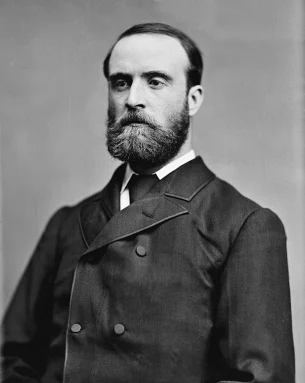
Charles Parnell
[Image description: A black and white photo of a white man with a high forehead and a thick, round beard. He is wearing a white button down and black tie and a grey double breast jacket.]
British Prime Minister Gladstone introduced the concept of Home Rule in 1880, with support from one of Ireland’s most famous statesmen: Charles Parnell. The entire purpose of Home Rule was to grant Ireland its own Parliament with seats available to both the Catholic majority and the Protestant minority and current power brokers). However, Parnell destroyed support for Home Rule by being involved in a messy and scandalous divorce and the Irish Republican Brotherhood (IRB), the precursor to the Irish Republican Army (IRA), scared the British government with their terrorist attacks. Home Role went through another failed iteration, but John Redmond was confident he would get the third iteration passed. This newest iteration was introduced to Parliament in 1914 and have created a bicameral Irish Parliament in Dublin, abolished Dublin Castle (the center of British power in Ireland), and continued to allow a portion of Irish MPs to sit in Parliament. It was supported by many nationalists in Ireland, barely tolerated by the Asquith Administration, and despised by the Unionists.
The Unionists believed they had a reason to worry. They had not forgotten the Protestants slaughtered during the 1798 Uprising nor the power they lost through the machinations of O’Connell and Parnell. Facing a massive change in their lives should Home Rule pass, the Unionists took a page out of the physical force book and created their own paramilitary organization: the Ulster Volunteers. The Asquith government knew of the Ulster Volunteers, their gun smuggling, and their drilling, but did nothing except delay Home Rule as long as possible.
Asquith’s delaying tactics and the creation of the Ulster Volunteers made Irish Nationalists nervous and they took matters into their own hand. Arthur Griffith, an Irish writer, politician, and the source of inspiration for many young rebels created the political party, Sinn Fein. Griffith argued for a dual monarchy approach, similar to the Austrian-Hungary model. He believed Ireland and England should be separate nations, united under a single monarchy. He also introduced the concept of parliamentary absenteeism i.e., Sinn Fein was a political party that would never sit in British Parliament, because the parliament was illegitimate.
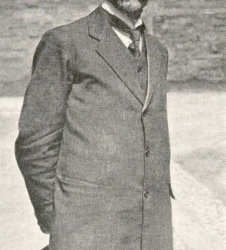
Eoin MacNeill
[Image description: A black and white picture of a tall man in a courtyard. He has a high forehead, wire frame glasses, and a shortly trimmed beard. He is standing with his hands behind his back holding a hat. He is wearing a white button down, a tie, a vest, and a suit jacket and grey pants.]
In response to the Ulster Volunteers, Eoin McNeill and Bulmer Hobson created the Irish Volunteers. Both men believed that the Irish wouldn’t stand a chance in an uprising against the British government and their best bet was to trust Redmond to pass Home Rule. The Irish Volunteers were created in order to defend their community from Unionist attacks. Things were tense in Ireland, but it seemed that parliamentary politics could save the day and the extremists would be pushed to the sidelines.
Then World War I began.
The British used the war to pass Home Rule but delay it taking affect for another three years. To add insult to injury, John Redmond encouraged young Irishmen to enlist in the British Army and fight for the Empire. McNeill and Hobson tried to convince its members to continue to trust Redmond, although they were angry that he was recruiting for the war. Yet, there was a handful of Irish Volunteers, who were also members of the resurrected IRB believed England’s difficulty, Irish opportunity.
They were Tom Clarke, Sean MacDiarmada, Padraig Pearse, Thomas MacDonagh, Eamonn Ceannt, and Joseph Plunkett. These men, plus James Connolly of the Irish Citizen Army, would sign the Proclamation of the Irish Republic and it would serve as their death warrant.
They knew they would not be able to win without arms and support, so, keeping their plans to themselves, they sent Roger Casement to Germany to present their plans for a German invasion that would coincide with an Irish rising. The Germans rejected this plan (maybe remembering what happened in 1798, when the French made a similar landing, weeks after a massive Irish uprising), but promised to send arms.
The Irish Volunteers were often seen drilling and practicing for some vague rebellion, so it wasn’t suspicious to the authorities or to MacNeil and Hobson to see units marching around. When Pearse issued orders for parade practice on April 23rd, Easter Sunday, MacNeil and Hobson took it at face value while those in the know, knew what it really meant. This surreal arrangement would not last for long and the committee’s secrecy nearly destroyed the very rising it was trying to inspire.
The first bit of trouble was Roger Casement’s arrest. The Germans were less than supportive of the uprising, and Casement boarded the ship Aud to return to Ireland to either stop or postpone the rising. However, when he arrived in Ireland on either April 21st or 22nd, he was pick up by British police and placed in jail.
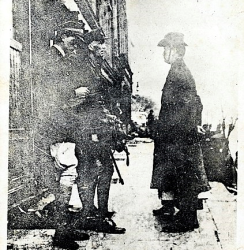
Pearse Surrenders
[Image description: A faded black and white photo of three men standing on a street in Dublin. There are two man on the left and they are wearing the khaki cap and uniform of the British army. On the right is a man wearing a wide brim hat and a long black jacket]
Then MacNeil and Hobson had their worst suspicions confirmed-Pearse and his comrades were secretly planning a rebellion without their support. MacNeill vowed to do everything (except going to the authorities) to prevent the Rising and sent out a counter-order, canceling the drills scheduled for Sunday. This counter-order took an already confused situation and turned it into a bewildering disaster. Units formed as ordered by Pearse and dispersed with great puzzlement and some anger and frustration. Pearse and his comrades met to discuss their next steps and decided the die had been cast. There was no other choice except to try again tomorrow, Monday, 24th, April 1916.
Easter Rising was concentrated in Dublin with a few units causing trouble on the city’s outskirts. The Irish rebels fought from Monday to Friday, surrendering Friday morning. The leaders of the rising were murdered, but many future IRA leaders such as Eamon DeValera, Michael Collins, Richard Mulcahy, Constance Markievicz, Liam Lynch, and others survived. They were sent to several different prisons, the most famous being Frongoch where Collins was held. The IRB turned it into a revolutionary academy and practiced their organizing and resistance skills while formalizing connections and relationships. When they were released starting in December 1916, they were ready to take those skills back to Ireland.
Creation of the IRA and the Dail
Their approach was two pronged: winning elections and rebuilding the Irish Volunteers/ Irish Republican Brotherhood.
When the prisoners were released, the Irish population went from hating them for launching a useless rebellion to cheering their return. The English helped flame the revolutionary spirit in Ireland by proclaiming Easter Rising a “Sinn Fein” rebellion and arresting many Sinn Fein members who had nothing to do with the Rising. This made it clear Sinn Fein was the revolutionary party while John Redmond’s party was out of touch.
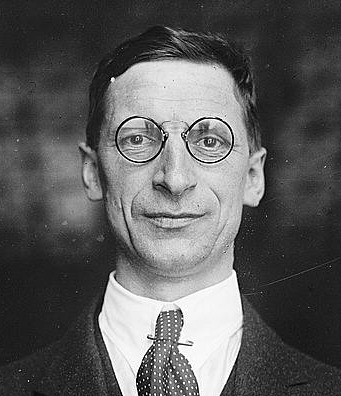
Eamon de Valera
[Image description: A black and white photo of a white man with a sharp nose and large, circular glasses. He has black hair and is wearing a white button down shirt, a polka dotted tie, and a grey suit.]
Sinn Fein ran several candidates such as Eamon DeValera, Michael Collins, and Thomas Ashe. Ashe would be arrested while campaigning and charged with sedition. While in jail, he went on hunger strike and was killed during a force feeding. Following an Irish tradition, Sinn Fein and the IRB turned Ashe’s funeral into a political lightning rod. They organized the funeral procession, the three-volley salute, and Collins spoke over Ashe’s grave: “There will be no oration. Nothing remains to be said, for the volley which has been fired is the only speech it is proper to make above the grave of a dead Fenian.”
On October 26th, 1917, Sinn Fein would hold their first national convention. During the convention, Eamon DeValera replaced Arthur Griffith as president and Sinn Fein dedicated itself to Irish independence with the promise that after independence was achieved the Irish people could elect its own form of government. However, there was still tension between those who believed in passive non-violence and the militant Sixteeners. 1917-1918 was spent building a bridge between parliamentary politics and militant politics of the 1920s, with Sinn Fein’s large young membership pushing it in a more militant direction.
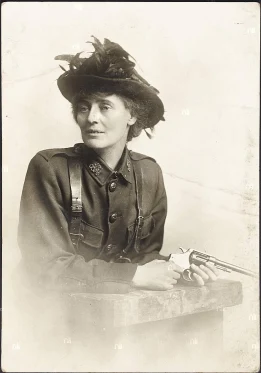
Constance Markievicz
[Image description: A sepia tone photo of a white woman looking to her right. She is leaning against a stool and holds a revolver. She wears a wide brim hat with black feathers and flowers. She has short hair. She is wear a military button down short and suspenders.]
Sinn Fein was also breaking social conventions, even though Cumann na mBan was still an auxiliary unit, Sinn Fein would allow four ladies on the Sinn Fein Executive and would run two women in the 1918 election-Constance Markievicz and Winifred Carney, with Markievicz becoming the first women to win a seat in parliament. Many of its supporters and campaigners were also women. In fact, many men would complain in 1917 and later that the women were more radical than the men. Cumann na mBan fully embraced the 1916 Proclamation and even had Hanna Sheehy-Skeffington deliver a message to President Wilson in 1918, asking him to recognize the Irish Republic. Cumann na mBan took the front line in the anti-recruitment campaign and the police boycott and the anti-conscription movement. Like the Volunteers, Cumann na mBan believed they were a military unit, although they never got arms for themselves and worked closely with Volunteer units and Sinn Fein clubs.
Irish Volunteers and IRB
While Sinn Fein was slowly rebuilding itself, the Irish Volunteers were also being resurrected from the ashes. It started with local initiatives led by men like Ernest Blythe, Eoin O’Duffy, and Sean Treacy. Units popped up in local communities, organized and armed by their local leaders and eventually contacting GHQ which consisted of men like Collins, Mulcahy, and Brugha. While local units were rebuilding themselves, Collins was using the IRB to form a strict corps of officers, a growing source of personal power as well as military power that men like Brugha and De Valera (who were IRB during Easter Rising, but renounced their membership after the rising failed) distrusted.
GHQ issued an order saying that units should only listen to orders coming from their own executive (in order to prevent the order-counter-order disaster that doomed Easter Rising) and swore the Volunteers would only be ordered into the field if commanders were confident of victory. No forlorn battles. Mulcahy, as Chief of Staff, worked hard to instill a military spirit and discipline into the Volunteers while understanding that their most effective unit at the moment was the company and local initiative. (The companies would expand into battalions and brigades as the war progressed, but the fighting and tactics would remain local and territorial) So, while trying to act like a regular army and expecting the Volunteers to respect their officers and GHQ, he also had to allow for local improvisation as well as trust the local executives to have control over their soldiers. It was a difficult balancing act he would struggle to maintain during the entire Anglo-Irish War and into the Irish Civil War and the formation of the Free Irish State.
The Irish Volunteers convention on October 26th, 1917, elected DeValera as president, Brugha as the chairman of the executive with Collins as director of organization and Mulcahy as director of training, Liam Lynch as Director of Communications, Staines, Director of Supply and Treasurer, O’Connor director of engineering.
All of this work could have been for nothing if the British hadn’t handed the IRA the greatest gift in the world: the 1918 conscription crisis.
Lightning Rod Issues
Food Shortage 1917-1918
Before conscription was the food shortages in the winter of 1917-1918. The shortage was created because of food being exported to Britain, invoking memories of the terrible famine. Sinn Fein could not stop all of the food being exported, but they did what they could to protest this newest version of starvation. For example, a member of Sinn Fein, Diarmund Lynch took thirty pigs meant to for exportation, killed them, and shared the food with hard hit families, earning him deportation to America, but becoming a local folk hero and increasing Sinn Fein’s prestige.
There were also agrarian tensions because grazers (those who used farmland for their cows to graze instead of growing crops) were given preference to available land so the Congested Districts Board could maximize profits. While this makes sense, it added to the great unease in the land, especially as the food shortage grew more acute.
The IPP grew out of the Land Wars of 1880s and Sinn Fein, ever aware of Irish history, decided it would be no different. It joined in the fight for land, arguing that all the ranch land should be broken up evenly. All over the country, Sinn Fein created commission to break up the land and figure out the pricing as well as organizing mass occupation of available land, but ranchers refused to acknowledge the prices Sinn Fein proposed.

1917 Electoral Victory March
[Image description: A black and white photo of several men and women marching together through a park with several tall green trees and a cobblestone wall. Leading the crowd are three men in long coats and wide brim hats playing bagpipes. Everyone else is wearing long coats, suit coats, or dresses and hats.]
The Irish Volunteers officially stayed out of the new land war, claiming it wasn’t military or political in nature, but local groups sometimes participated. This combined with Sinn Fein’s own land seizures could lead to painful confrontations with police and other anger Irish men, so it was a difficult job balancing non-violent and not starting a mass uprising.
Another tool Sinn Fein used was boycotting. Said to original in Ireland during the Land Wars and used to great affect by Charles Parnell, Sinn Fein boycotted the RIC. This was a serious threat to the British system, decreasing the pool of candidates it could recruit from for the RIC and training the people to view the RIC as “others,” the first step to making a population comfort with violent action.
Boycotting the RIC was an old idea, something Sinn Fein and the Irish Volunteers wanted to implement it as soon as they were released from prison. This became a strong tool of the Volunteers to ostracize those who were betraying the rebel cause by working for the British as well as prepare the citizens for a war mentality.
Conscription crisis
No one yet knew that World War I would be over by November 11th, 1918. British thought she was facing long years of further bitter sacrifices and they needed new blood. They looked at Ireland and its large set of unruly young men itching for a fight and introduced the Military Service bill, extending forced conscription to Ireland-giving the Volunteers a shot in the arm while also uniting the Irish political parties, for the first time ever.
The Sinn Fein, IPP, and the Catholic Church pledged to resist Britain’s efforts to conscript Irishmen. DeValera prepared a statement, meant for Woodrow Wilson, insisting that their resistance was a battle for self-determination and principles of civil liberty, similar to the American’s cause during America’s revolution. The Volunteers planned local actions as well, using the conscription crisis as a springboard for intensive recruiting and introducing the idea of militant resistance into the greater Irish consciousness. The boycott of the RIC increased tenfold during the anti-conscription movement, shocking the police and trapping them in their barracks in locations such as North Tipperary. Women were particularly effective implementers of the boycott. Eventually the boycott was expanded to include those who helped or associated with the police. The boycott didn’t force many police to resign, but it built a belligerent and hateful mindset against the police-allowing for later violence.
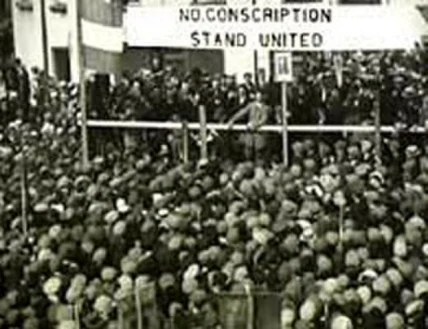
Anti-conscription Rally in Ballaghaderreen County
[Image description: A blur black and white photo of a large gathering of people. They are surrounding a wooden platform where as group of men stand. Above the platform there is a white banner that says: No conscription Stand United]
The Irish Volunteers were not as engaged with the conscription crisis as Sinn Fein, because they still didn’t have a doctrinal strategy in place. Instead, volunteers were told to avoid getting arrested and if the RIC tried to arrest them, to resist. The Volunteers held daily drills and parades and prepared for battle, should the order ever arrive. However, GHQ seemed more concerned with getting rifles and ammunition than ordering a massive uprising. Conscription allowed them to demand that the local area their units controlled give up their guns to the Irish Volunteers. Some Volunteers even bought rifles off RIC or local British soldiers. Lack of guns would be a problem that plagued the IRA through their war with the British. Conscription also saw a spike in people joining the Irish Volunteers. GHQ tried to manage this wave of volunteers by issuing orders regarding how men should be recruits and how they should be vouched for and accepted.
The Irish Volunteers allowed their own soldiers to elect their officers (how could this go wrong?) GHQ seemed to try and curb who could be elected like requiring that they be member of the IRB, but given the haphazard nature these units were created, but it was only somewhat successful, some units merging the Volunteers and IRB men seamlessly, while other companies were dominated by non-IRB men or vice versa.
They threatened mass slaughter should Britain try to enforce conscription and, apparently, there was a plan for Cathal Brugha to lead a group of men to assassin the British cabinet (relying on Collins and Mulcahy-who was now chief of staff-to recruit for this venture).
German Plot
The British back down on conscription in mid-May while also arresting 73 nationalist leaders from May 17-18 under the Defense of the Realm Act, including Eamon DeValera, Constance Markievicz, Arthur Griffith, and William Cosgrave. They claimed there was a German plot i.e., Sinn Fein was working with Germany-like the 1916 rebels did and the 1798 rebels with the French.
It quickly became clear how flimsy the excuse was, that there was scant information, and undermined the government’s credibility in Ireland. It successfully knocked Sinn Fein off its feet for a moment, especially since all nine of the twenty-one members of Sinn Fein’s Standing Committee were arrested, but the British failed to arrest some of the most dangerous rebels such as Collins, Brugha, Mulcahy, and Harry Boland. But in the long run, it boosted Sinn Fein’s cause and destroyed any chance IPP had of reclaiming the national narrative. As Constance Markievicz claimed, "sending you to jail is like pulling out all the loud stops on all the speeches you ever made…our arrests carry so much further than speeches.”
1918 Election
Sinn Fein had won a total of five elections between 1917 and 1918 (De Valera, Count Plunkett, Cosgrave, Patrick MacCartan, and Griffith) and lost two elections. 1918 was their first general election. The election was held on December 14th, 1918, and is considered one of the most important moments in modern Ireland’s history. It was the first election after the end of the First World War and, because of the Representation of the People Act, women over the age of 30 and working-class men over the age of 21 could vote, tripling the Irish electorate from 700,000 in 1910 to 1.93 million in 1918.
The IPP won only 6 seats, the Unionists took 26 seats, and Sinn Fein won 73 seats.
The Sinn Fein victory can be explained in three different ways:
The new electoral: women and working-class men: people who had been hardest hit by the war and the rising and the conscription crisis, as well as the good shortage in 1917.Not only was Sinn Fein and Irish Volunteers campaigning, but Cumann na mBan campaigned hard as well, possible driving people into the arms of Sinn Fein since Sinn Fein stood for a republic which was against everything as it currently was. iSinn Fein’s rivals: the IPP and Labour had been broken by WWI and needed to rebuild themselves and their reputations if they wanted to compete.
The clergy was on Sinn Fein’s side because of conscription. DeValera also went a long way to argue that anti-conscription was not anti-soldiers nor were they ignoring the sacrifice of the Irishmen who had fought in the war so far. But the crime was that Britain sacrificed the best Ireland had for a colonial war.
Curated candidates. Sinn Fein ran those it was confident would win and in seats that would not weaken its own position or risk schism with the Labor movement. Also, there was some election rigging and voter intimidation.
Instead of sitting in parliament, the Sinn Fein candidates would sit in a new parliament: the first Dail of Eireann.
The Dail
The First Dail was formed on January 21st, 1919. It held its first meeting in the Round Room of the Mansion house of Dublin and created a Declaration of Independence and the Dail Constitution. Only 27 minsters appeared because 34 were in jail or on secret missions. Sinn Fein invited the IPP and Unionists to participate but they refused. The declaration of independence ratified the Proclamation of the Republic of Easter Rising and outlined a socialist platform, but it was more of a propaganda message because there was only so much the Dail could realistically achieve while battling England.
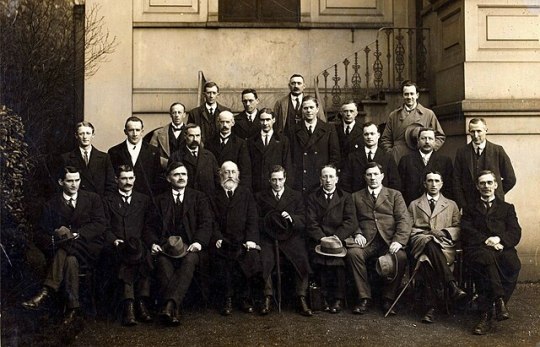
Members of the First Dail
[Image description: A black and white photo of three rows of men. The first row of men are sitting down on chairs, the second and third rows of men are standing. Most men are wearing black suits with white button down shirts and ties. Others are wearing tan or grey jackets. Some men had beards and mustaches, but most are clean shaven. Behind the men is a metal staircase and a white building.]
The constitution was a provisional document and created a ministry of the Dail Eireann. The ministry consisted of a President and five secretaries. First ministers of the Dail were:
Chairperson of the Dail: Cathal Brugha (because DeValera was in jail and Collins and Harry Boland were planning how to break him out)
Minister for Finance: Eoin MacNeill
Minister for Home Affairs: Michael Collins
Minister for Foreign Affairs: Count Plunkett
Minister for National Defense: Richard Mulcahy
The Dail expanded the number of ministers in April. It now included nine ministers within the cabinet and four outside the cabinet as well as a mechanism to create substitute presidents and ministers in the realistic event someone was arrested or killed.
This second ministry members were:
President: DeValera
Secretary for Home Affairs: Arthur Griffith
Secretary for Defense: Cathal Brugha
Secretary for Foreign Affairs: Count Plunkett
Secretary for Labour: Constance Markievicz
Secretary for Industries: Eoin MacNeill
Secretary for Finance: Michael Collins
Secretary for Local Government: W. T. CosgraveAustin Stacks would become minster after his release from jail and then took over as secretary for home affairs after Griffith became deputy president.
Once the Dail was convened, the Irish Volunteers saw themselves as an army of an Irish Republic hence why they named themselves the Irish Republican Army. They were formally renamed the IRA on August 20th, 1919, and took an oath of allegiance to the republic and to serve as a standing army.
On June 18th, 1919, the Dail officially established the Dail courts which were meant to replace the British judiciary. They eventually created several series of courts including a parish-based arbitration courts, district courts, and a supreme court which the people trusted more than the British courts. On June 19th, the Dail approved the First Dail Loan to raise funds they couldn’t raise via taxes. Collins would also create a bond scheme which helped keep the Dail and the IRA financially afloat.
England declared the Dail illegal in September 1919, but it was too little too late to undermine Ireland’s shadow government. DeValera left Ireland to fundraise in the United States, leaving Griffith as his Deputy President. The conduct of the Dail fell to its ministers while the conduct of the war fell to Collins, Mulcahy, Brugha, and the field commanders.
BRIEF Summary of Guerrilla Warfare in Ireland
The IRA would be broken into General Headquarters (GHQ) and local commanders. GHQ was run by Chief of Staff Richard Mulcahy who answered to Cathal Brugha, the Minister of Defense. Mulcahy also worked closely with Michael Collins, Minister of Finance and Intelligence and this amorphous command structure created a lot of tension amongst the three men. While Mulcahy tried to install discipline and standardization from GHQ, he was only partially successful as conditions on the ground often trumped whatever master plan GHQ had cooked up.

Richard Mulcahy
[Image description: A sepia toned photo of a thin white man with a prominent nose. He is wearing the military cap and uniform of the Irish National Army.]
It's estimated that the IRA had 15,000 members but only 3,000 were active at one time. The members were broken into three groups: unreliable, reliable, and active. Unreliable meant they were members in name only, reliable meant they played a supporting role, and active meant they were full-time fighters. It’s believed at least 1/5 of the active members were assistants and clerks. Skilled workers dominated the recruitment while farmers and agricultural workers were a minority. About 88% percent of the IRA members were under thirty and a majority of them were Catholics. The most active units were in Dublin County and Munster County which includes the cities of Clare, Cork, Kerry, Limerick, Tipperary, and Waterford.
The local units were supposed to be organized along the lines of a battalion but it was up to the local commanders, who were originally elected by their men. Initially, GHQ tried to assign two to three brigades to a county, but it would take a while before those brigades solidified. For the first year, the IRA could only muster small units, which actually worked in their favor.
Local commanders adopted the “flying columns” method of attack and GHQ eventually gave it their blessing. Flying columns consisted of a permanent roster of soldiers who worked together in small groups in coordinated attacks. The flying columns performed two kinds of attacks: auxiliary and independent
In an auxiliary attack, the flying column was assigned to a battalion as extra support for a large local operation already taking place. In an independent attack, the flying column itself would strike the enemy and retreat. This type of attack included harassing small military camps and police stations, pillaging enemy stories, interrupting communications, and eventually ambushes. The flying columns would become an elite and coveted unit but its soldiers were always on the run and relied on local support to survive.

Michael Collins
[Image description: A black and white photo of a white man shouting to a large crowd. He is standing outside on a platform, in the middle of a city street. He has short hair and is clean shaven. He is wearing a white shirt and a black suit.]
The IRA would go through two different reorganizations. The first occurred in March 1921. It broke up the brigade structure into small columns, built from experienced men. The brigade staff existed to provide supplier of arms, ammunition, and equipment while battalions provided the men for the columns. During the same reorganization, GHQ broke Ireland up into four different war zones to encourage activity in quieter areas.
In late 1921, the IRA was organized a second time. This time, GHQ created divisions. Division commanders were responsible for large swaths of territory, similar to the war zones created earlier that year. The purpose of the divisional commanders was to increase the likelihood of brigade and battalion coordination, make the IRA feel like it was growing into a real army, but still allowed (and encouraged) independent command, and transplant some of the administrative burden from GHQ to the divisional commanders. This was especially important if something were to happen to GHQ.
You can listen to season 1 to learn about specific battles. For the purpose of this recap, all you really need to know is that the IRA went from singular ambushes lead by ambitious local commanders to coordinated ambushes, assassinations (the most famous being Bloody Sunday carried out by Collins’ personal assassins), prison riots, hunger strikes, and outright assaults on barracks in the rural areas of Ireland. In addition to these military developments, the Dail supported the war effort by retaining the people’s support and maintaining the functionality of the Dail Courts and the Dail Loans.
The British responded by implementing martial law, launching large scale searches and arrests, curfews, roadblocks, and interment on suspicion and by creating the Black and Tans and the Auxiliaries. The Black and Tans arrived in Ireland on March 25th, 1920. They were meant to reinforce the RIC and recruited mostly British veterans. They were called black and tans because of their uniform (dark green which appeared black and khaki. They weren’t special forces, just normal reinforcements which may explain why they were known for their brutality and violence. The auxiliaries were founded in July 1920s as a paramilitary unit of the RICs. It consisted of British officers and were meant to serve as a mobile strike and raiding force. 2,300 men served during the war and they were deployed in the southern and western regions of Ireland – where fighting was the heaviest. They were absolute brutes, known for arson and cruelty.
The British wanted to subdue Ireland by the May 1921 election, so they sent over fifty-one battalions of infantry, however, confusion over the military’s role, the RIC’s role, an inability to coordinate amongst the army, RIC, Black and Tans, and Auxiliaries, and the implementation of martial law hurt British efforts.
The IRA were feeling the pressure. In early 1921, they suffered some of their most drastic defeats contributing to poor morale and disgruntlement with the Dail and GHQ. GHQ was losing control over local forces while also trying to maintain a guerrilla war on a shoestring budget. To make matters worse, DeValera returned from America in December 1920 and spent most of 1921 trying to reorganize the IRA and Dail according to his vision. His arrival exasperated already existing tensions amongst several ministers, including Collins, Mulcahy, and Brugha, and threatened to tear the IRA apart from the inside.
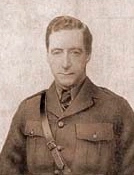
Cathal Brugha
[Image description: A sepia toned photo of a small and thin man in a military uniform and a white button down and stripped tie. He has short hair and is clean shaven. Behind him is a blank white wall.]
Despite all of this, by May 1921, the IRA had reached its peak and the crown forces suffered record losses. From the beginning of 1921 to July, the IRA killed 94 British soldiers and 223 police officers. This was nearly double the totals from the last six months of 1920. This was also when the IRA launched their most ambitious attacks such as their attack on the Shell factory which amounted to 88,000 pounds in damage and their assault on the Dublin Custom House destroying the inland revenue, stamp office, and stationery office records. In addition to these attacks, the IRA increased the number and sophistication of their attacks in what is now Northern Ireland. However, these attacks could be self-defeating as they only enraged the Ulster Volunteers and left the Catholic population at the mercy of angry Unionists. These attacks would convince the British that Ireland was already partitioned (even if Sinn Fein and the IRA refused to acknowledge the fact) and it was in their interest to protect Northern Ireland from IRA incursions. This meant another army and more money that could have been spent elsewhere.
It was clear that neither side could win this conflict through military efforts alone.
References:
The Republic: The Fight for Irish Independence by Charles Townshend, 2014, Penguin Group
Fatal Path: British Government and Irish Revolution 1910-1922by Ronan Fanning, 2013, Faber & Faber
Richard Mulcahy: From the Politics of War to the Politics of Peace, 1913-1924 by Padraig O Caoimh, 2018, Irish Academic Press
A Nation and Not a Rabble: the Irish Revolution 1913-1923by Diarmaid Ferriter, 2015, Profile Books
Eamon DeValera by Ronan Fanning, 2016, Harvard University Press
#Irish War of Independence#Irish History#Michael Collins#Richard Mulcahy#Irish Republican Army#IRA#Eamon Devalera#Cathal Brugha#Constance Markievcz#easter rising#history blog#queer historian#podcast episode#Spotify
11 notes
·
View notes
Text
someone asked if political party colours were backwards in the UK compared to the US and I got carried away explaining that uh
US:

UK:

it's a bit more complicated than that
this is all 14 parties in the UK which either have seats in the House of Commons, in the House of Lords, or who are currently polling at over 1% of vote share.
Across the top are the national parties; Greens, Labour, and Liberal Democrats on the left, and the Convervatives, Reform (neé Brexit), and UKIP on the right.
Along the bottom are the regional parties; Sinn Féin (Northern Ireland), Plaid Cymru (Wales), Scottish National (Scotland), Social Democratic and Labour (NI), Alliance (NI) on the left, and the Ulster Unionists (NI), Democratic Unionists (NI) and Alba (Scotland) on the right.
9 notes
·
View notes
Text
Lords Vote
On: Water (Special Measures) Bill [HL]
Lord Roborough moved amendment 11, in clause 1, page 4, line 25, at end to insert— “(5) The first rules issued under section 35B of the Water Industry Act 1991 (as inserted by subsection (3)) must be published by the Authority within six months of this Act coming into force and provided to the Secretary of State and do not take effect until the Secretary of State has made regulations made by statutory instrument to bring them into effect. (6) A statutory instrument containing regulations under this section may not be made unless a draft of the instrument has been laid before and approved by a resolution of each House of Parliament.” The House divided:
Ayes: 140 (92.9% Con, 2.9% XB, 2.1% , 1.4% UUP, 0.7% DUP) Noes: 117 (91.5% Lab, 6.0% XB, 1.7% , 0.9% PC) Absent: ~573
Likely Referenced Bill: Water (Special Measures) Bill [HL]
Description: A Bill to make provision about the regulation, governance and special administration of water companies.
Originating house: Lords Current house: Lords Bill Stage: Report stage
Individual Votes:
Ayes
Conservative (130 votes)
Agnew of Oulton, L. Altrincham, L. Anelay of St Johns, B. Arbuthnot of Edrom, L. Ashcombe, L. Bailey of Paddington, L. Balfe, L. Banner, L. Barran, B. Bellingham, L. Berridge, B. Bloomfield of Hinton Waldrist, B. Booth, L. Booth-Smith, L. Borwick, L. Bourne of Aberystwyth, L. Brady of Altrincham, L. Brady, B. Browning, B. Brownlow of Shurlock Row, L. Caine, L. Caithness, E. Cameron of Chipping Norton, L. Cameron of Lochiel, L. Camrose, V. Carrington of Fulham, L. Clarke of Nottingham, L. Colgrain, L. Courtown, E. Cruddas, L. Davies of Gower, L. De Mauley, L. Dobbs, L. Duncan of Springbank, L. Dundee, E. Effingham, E. Evans of Bowes Park, B. Evans of Rainow, L. Finn, B. Fookes, B. Forsyth of Drumlean, L. Foster of Oxton, B. Fraser of Craigmaddie, B. Frost, L. Fuller, L. Gascoigne, L. Glenarthur, L. Godson, L. Goodman of Wycombe, L. Grimstone of Boscobel, L. Hamilton of Epsom, L. Harlech, L. Hayward, L. Helic, B. Henley, L. Hodgson of Abinger, B. Hodgson of Astley Abbotts, L. Hooper, B. Horam, L. Howard of Lympne, L. Howell of Guildford, L. Hunt of Wirral, L. Jackson of Peterborough, L. James of Blackheath, L. Jamieson, L. Jopling, L. Kempsell, L. Kirkhope of Harrogate, L. Laing of Elderslie, B. Lawlor, B. Lea of Lymm, B. Lilley, L. Mackinlay of Richborough, L. Magan of Castletown, L. Mancroft, L. Manzoor, B. Maude of Horsham, L. McInnes of Kilwinning, L. McIntosh of Pickering, B. Mendoza, L. Meyer, B. Minto, E. Monckton of Dallington Forest, B. Morris of Bolton, B. Mott, L. Moylan, L. Moynihan of Chelsea, L. Moynihan, L. Murray of Blidworth, L. Neville-Jones, B. Neville-Rolfe, B. Newlove, B. Northbrook, L. Norton of Louth, L. O'Neill of Bexley, B. Owen of Alderley Edge, B. Parkinson of Whitley Bay, L. Petitgas, L. Pidding, B. Porter of Spalding, L. Reay, L. Redfern, B. Remnant, L. Roberts of Belgravia, L. Roborough, L. Rock, B. Sanderson of Welton, B. Sandhurst, L. Sater, B. Scott of Bybrook, B. Sharma, L. Sharpe of Epsom, L. Sherbourne of Didsbury, L. Shinkwin, L. Smith of Hindhead, L. Stedman-Scott, B. Sterling of Plaistow, L. Stowell of Beeston, B. Sugg, B. Taylor of Holbeach, L. True, L. Udny-Lister, L. Verma, B. Waldegrave of North Hill, L. Whitby, L. Williams of Trafford, B. Wolfson of Tredegar, L. Wrottesley, L. Young of Cookham, L. Younger of Leckie, V.
Crossbench (4 votes)
Alton of Liverpool, L. Berkeley of Knighton, L. Craigavon, V. Devon, E.
Non-affiliated (3 votes)
Faulks, L. Foster of Aghadrumsee, B. Lampard, B.
Ulster Unionist Party (2 votes)
Elliott of Ballinamallard, L. Empey, L.
Democratic Unionist Party (1 vote)
Dodds of Duncairn, L.
Noes
Labour (107 votes)
Adams of Craigielea, B. Alli, L. Anderson of Stoke-on-Trent, B. Anderson of Swansea, L. Bassam of Brighton, L. Beamish, L. Blackstone, B. Blake of Leeds, B. Blower, B. Bradley, L. Brooke of Alverthorpe, L. Browne of Ladyton, L. Bryan of Partick, B. Campbell-Savours, L. Chapman of Darlington, B. Clark of Windermere, L. Cryer, L. Donaghy, B. Drake, B. Dubs, L. Falconer of Thoroton, L. Faulkner of Worcester, L. Foulkes of Cumnock, L. Gale, B. Golding, B. Goldsmith, L. Goudie, B. Grantchester, L. Griffiths of Burry Port, L. Grocott, L. Gustafsson, B. Hain, L. Hannett of Everton, L. Hanson of Flint, L. Hanworth, V. Harman, B. Harris of Haringey, L. Hayman of Ullock, B. Hayter of Kentish Town, B. Healy of Primrose Hill, B. Hendy of Richmond Hill, L. Hendy, L. Hermer, L. Howarth of Newport, L. Hunt of Kings Heath, L. Jones, L. Kennedy of Cradley, B. Kennedy of Southwark, L. Kennedy of The Shaws, B. Khan of Burnley, L. Kinnock, L. Knight of Weymouth, L. Lawrence of Clarendon, B. Leong, L. Liddle, L. Lipsey, L. Lister of Burtersett, B. Livermore, L. Mallalieu, B. Mandelson, L. McIntosh of Hudnall, B. McNicol of West Kilbride, L. Merron, B. Monks, L. Morris of Yardley, B. Murphy of Torfaen, L. O'Grady of Upper Holloway, B. Osamor, B. Pitkeathley, B. Ponsonby of Shulbrede, L. Prentis of Leeds, L. Prosser, B. Quin, B. Ramsey of Wall Heath, B. Rebuck, B. Reid of Cardowan, L. Ritchie of Downpatrick, B. Rowlands, L. Sahota, L. Shamash, L. Sherlock, B. Sikka, L. Smith of Basildon, B. Smith of Cluny, B. Smith of Malvern, B. Spellar, L. Stansgate, V. Stevenson of Balmacara, L. Symons of Vernham Dean, B. Taylor of Bolton, B. Taylor of Stevenage, B. Thornton, B. Timpson, L. Touhig, L. Tunnicliffe, L. Twycross, B. Vallance of Balham, L. Warwick of Undercliffe, B. Watson of Invergowrie, L. Watts, L. Wheeler, B. Whitaker, B. Whitty, L. Wilcox of Newport, B. Winston, L. Wood of Anfield, L. Young of Old Scone, B.
Crossbench (7 votes)
Carrington, L. Colville of Culross, V. Hogan-Howe, L. Macpherson of Earl's Court, L. Meacher, B. Patel, L. Watkins of Tavistock, B.
Non-affiliated (2 votes)
Austin of Dudley, L. Patel of Bradford, L.
Plaid Cymru (1 vote)
Smith of Llanfaes, B.
0 notes
Text
Exit of Ulster Unionist leader leaves party at a crossroads
Once dominant organisation is struggling to appeal to younger voters in a fragmented political landscape
0 notes
Text
Doug Beattie has resigned as leader of the Ulster Unionist Party (UUP) on Monday. In a statement this morning, Mr Beattie said that while the UUP had seen successes in the recent Westminster election last month, he has had “irreconcilable differences” with his party officers. The Upper Bann Assembly member, who is a decorated Army veteran, was elected UUP leader in 2021. From the liberal wing of unionism, Mr Beattie took on the role, pledging a progressive agenda and a move toward the middle ground. His resignation comes after what was a relatively positive general election result for the UUP, with the party securing a Westminster seat for the first time since 2017. -Mr Beattie said it had been a “huge honour” to lead the party. “It has not been easy and at times it has been both lonely and isolating,” he said.
continue reading
That's a pity. He was the only progressive unionist leader, when compared to the others. I hope whoever replaces him isn't another run-of-the-mill unionist.
0 notes
Text
Waking to Google Assistant having provided me with political articles for my morning read is annoying. I've been repeatedly encouraging science, music, culture and skipping or blocking political stuff.
But to wake this morning to find that the globe trotting Google Assistant has served me up an article from the fucking News Letter, local rag that serves as the propaganda wing of the DUP, low key hilarious. Especially after reading the article.
Getting this bunch of deplorables to agree on the shade of shite would be the greatest trick since christ walked on water.
1 note
·
View note